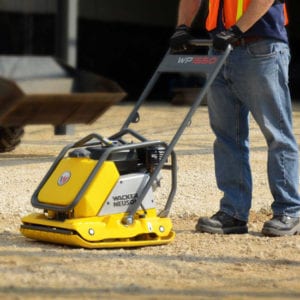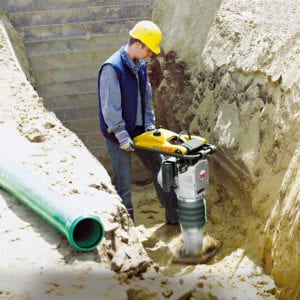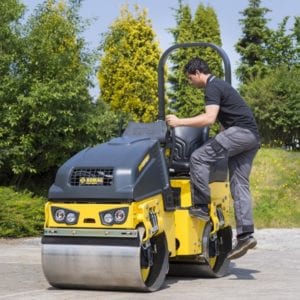If you understand the importance of a properly compacted surface in supporting a building or a roadway, you also know how crucial it is to select the correct compactor for the job. Whether you’re working with granular or cohesive soil (or a mixture of both), you have plenty of choices to consider.
Match the Material to the Compactor
The principal factor in choosing compaction equipment is material type – granular versus cohesive.
Granular Soils (Gravel and Sand)

Plate Compactor – WP1550A Wacker Neuson
Granular soil is best compacted with a vibratory action, such as from a plate. As long as the area being compressed isn’t deeper than 6 inches, a plate vibrator will do the job well for a small- or medium-sized area. For deeper material or a large surface area, vibratory rollers are more efficient and work equally well.
As a granular material, asphalt calls for compaction by vibration and pressure work for the best result. As mentioned above, use a vibratory plate unless you have a large area like a driveway or roadway. In that case, use a double-drum vibratory roller.
Cohesive Soils (Clay and Silt)
In general, the “stickier” the soil, the more difficult it is to compact. This is because the particles stick together, making it a challenge to rearrange them and force the air out.
To compress clay and other cohesive material, you’ll need equipment with more “punch,” like a rammer. However, rammers are best suited for smaller work areas, such as in trenches and around foundations. If you have a large area to compress, a vibratory roller also does the job as long as you use a pad-foot type roller.
Consider Other Compaction Factors
Although soil type is the most important factor in choosing compaction equipment, other aspects affect compaction quality:
- Moisture content
- Size of soil particles
- Over- and under-compaction
Moisture Content

Rammer Compactor – Wacker Neuson
While not significant for granular material, moisture is an extremely critical issue in cohesive soil.
Saturated Cohesive Soil
The amount of moisture in the soil affects compaction because it acts as a lubricant to help the soil particles slide more closely together. But if the soil is too moist, it can cause a problem. It might appear to be compacted, but water-filled voids will still exist. When voids are completely filled with water, there’s no force to hold the particles together, and compaction isn’t effective.
Dry Cohesive Soil
Overly dry soil doesn’t hold its shape well. This means that compaction will be inadequate, the material tending to crack.
Size of Soil Particles
When working with granular soil, the various sizes of the particles react differently to the various frequencies (vibrations) used.
- Smaller particles—Need higher frequency, like those applied by vibratory plates.
- Larger particles—Need lower frequency from larger equipment like a vibratory roller.

Compaction Roller – Bomag BW 90 AD-5
Over-compaction and Under-compaction
Professionals who regularly work with compaction equipment and different soil types usually don’t have issues with over- or under-compaction. However, a DIYer needs to be aware of these problems, as they can cause just as many difficulties as not compacting at all!
Over-Compaction
Over-compaction actually breaks the soil down into smaller particles, changing its composition. Overly compact material is more brittle, which can lead to cracks. To avoid this, review your equipment’s compaction rating (how deeply it compacts soil) and compare it to the soil depth you’re actually working with.
Under-Compaction
Under-compaction can occur if the operator chooses equipment that:
- Isn’t powerful enough for the soil type.
- Isn’t appropriate for the soil depth.
- Isn’t efficient for the size of the job (i.e., missed spots or too few passes).
Questions About Compaction Equipment?
If you’re not sure which compaction equipment is best for your job, call Pro Group experts at (857) 706-2980, and we can walk you through the selection process. You can also request a quote on any of our plate compactors, rammers, or rollers – for rent or for purchase.



